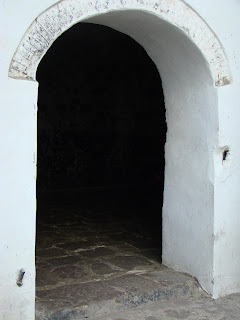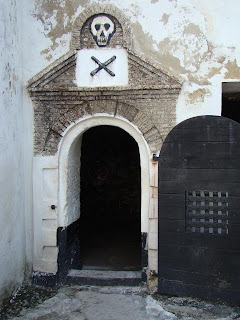 Before Ghana gained its independence from Britain in 1957, it was known as Gold Coast. This is because at one time, 1/10 of the world’s gold came from this area. Unfortunately, this region is also known, certainly more infamously, for its massive export of slaves. Aside from the residual, colonial impact of Britain (and other colonizing nations present at various times…hmmm, what does this make me?) in terms of government, language, education and culture in general, Ghana has also had to come to terms with a long history of slave trade.
Before Ghana gained its independence from Britain in 1957, it was known as Gold Coast. This is because at one time, 1/10 of the world’s gold came from this area. Unfortunately, this region is also known, certainly more infamously, for its massive export of slaves. Aside from the residual, colonial impact of Britain (and other colonizing nations present at various times…hmmm, what does this make me?) in terms of government, language, education and culture in general, Ghana has also had to come to terms with a long history of slave trade. 
Evidence of this is spotted along the coast of Ghana in the great and terrible beauty of some incredibly well-preserved remnants and buildings that were key posts at the height of the Atlantic slave trade. The Ashanti people in Ghana were significant capturers and traders of fellow Africans and the “castles” along the coast were the point of no return for all too many Africans. We visited two of these castles, though we only entered and took the tour in one: Elmina Castle (a.k.a. St. George Castle; pictured in both of the above shots).

The castle was built by the Portuguese in 1482 and was originally named St. George of the Mine Castle. Later the Dutch seized the castle and it eventually became part of the British Empire. Today under the restorative guidance of the Ghanaian people, it is recognized as a UNESCO World Heritage Site. Elmina Castle is said to be one of the oldest European buildings outside of Europe and North Africa, and it is, rather incredibly, in near-pristine condition compared with most buildings of its vintage.
 It was pointed out, as we were standing in the small, lightless, featureless dungeon (doorway above) where over a hundred women were stacked to await systematic rape, torture and transport (should they prove their market value by surviving long enough to be shipped), that the stench of barbaric containment and inhuman conditions was very much alive in the walls, and it was hard to deny. If my use of language comes of as overly graphic or terse, I can assure you that this is only a gentle whisper compared to the nature of our guide’s description. While it was a little awkward explaining and decoding what we had heard to the children after the tour, it is the truth, and the truth is always necessary when setting to the twin tasks of remembering and paying due respect.
It was pointed out, as we were standing in the small, lightless, featureless dungeon (doorway above) where over a hundred women were stacked to await systematic rape, torture and transport (should they prove their market value by surviving long enough to be shipped), that the stench of barbaric containment and inhuman conditions was very much alive in the walls, and it was hard to deny. If my use of language comes of as overly graphic or terse, I can assure you that this is only a gentle whisper compared to the nature of our guide’s description. While it was a little awkward explaining and decoding what we had heard to the children after the tour, it is the truth, and the truth is always necessary when setting to the twin tasks of remembering and paying due respect.  The private tour (included in the modest admission charge) was informative, moving and disturbing in equal parts. We were ushered through the castle, much as a slave would have been, so that we could have some small understanding of what went on inside the dense, white walls of this seaside fort. The cell (pictured above) would house up to thirty Africans who had been condemned to death after being brought to the fort. The room had no facilities and the prisoners would be left together in the cell until the last one was dead.
The private tour (included in the modest admission charge) was informative, moving and disturbing in equal parts. We were ushered through the castle, much as a slave would have been, so that we could have some small understanding of what went on inside the dense, white walls of this seaside fort. The cell (pictured above) would house up to thirty Africans who had been condemned to death after being brought to the fort. The room had no facilities and the prisoners would be left together in the cell until the last one was dead. This slender gap in the castle wall was the last time many would feel their feet on African land, as they were loaded onto waiting ships. As we passed—literally and figuratively—back through the “door of no return,” we were encouraged to utter a pledge of “never again.” I must say that while the story is not mine (though admittedly, as a descendant of the Britain, I bear at least some of the responsibility), I uttered the pledge with as much sincerity and conviction as I have ever spoken. As we escaped the dungeon, shifting once more into the warm African light, we were far better off knowing this truth with our eyes and within our hearts, than we would ever be resting in ignorance.
This slender gap in the castle wall was the last time many would feel their feet on African land, as they were loaded onto waiting ships. As we passed—literally and figuratively—back through the “door of no return,” we were encouraged to utter a pledge of “never again.” I must say that while the story is not mine (though admittedly, as a descendant of the Britain, I bear at least some of the responsibility), I uttered the pledge with as much sincerity and conviction as I have ever spoken. As we escaped the dungeon, shifting once more into the warm African light, we were far better off knowing this truth with our eyes and within our hearts, than we would ever be resting in ignorance. There are a number of Africans who believe that these buildings must be torn down so that the terrible past can be buried. It does seem somewhat grotesque that this has become one of West Africa’s most important tourist “attractions.” I must admit—with no small degree of shame—to feeling something akin to what I felt when I first laid eyes on some of the castles in England and Scotland: a mix of awe and admiration. For the most part, the history and idealism of the “great man” (in Africa, Canada, or elsewhere) is a fallacy and a travesty perpetuated on countless millions, even to this day. However, I don’t think that tearing down the buildings—now rightfully in the hands of Ghanaians, whose story it is to tell—will improve the chances that this will “never again” take place. The above picture of a midday football match may seem a little out of place, given the content of this entry, but it was very much "in place" as I snapped it from atop the castle wall. It provided a degree of comfort to know that in many ways, Africa is alive and well.
There are a number of Africans who believe that these buildings must be torn down so that the terrible past can be buried. It does seem somewhat grotesque that this has become one of West Africa’s most important tourist “attractions.” I must admit—with no small degree of shame—to feeling something akin to what I felt when I first laid eyes on some of the castles in England and Scotland: a mix of awe and admiration. For the most part, the history and idealism of the “great man” (in Africa, Canada, or elsewhere) is a fallacy and a travesty perpetuated on countless millions, even to this day. However, I don’t think that tearing down the buildings—now rightfully in the hands of Ghanaians, whose story it is to tell—will improve the chances that this will “never again” take place. The above picture of a midday football match may seem a little out of place, given the content of this entry, but it was very much "in place" as I snapped it from atop the castle wall. It provided a degree of comfort to know that in many ways, Africa is alive and well.  We went to the city of Cape Coast, the location of the other, perhaps better known castle in the area, but we felt we were done for the day so we did not enter. We intend to return and will likely bring any visitors that we have to one of the two castles, to hear this story again and pay our respects.
We went to the city of Cape Coast, the location of the other, perhaps better known castle in the area, but we felt we were done for the day so we did not enter. We intend to return and will likely bring any visitors that we have to one of the two castles, to hear this story again and pay our respects.Never again.

No comments:
Post a Comment